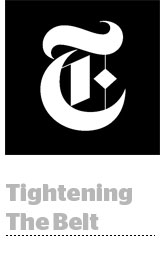 Here’s today’s AdExchanger.com news round-up… Want it by email? Sign up here.
Here’s today’s AdExchanger.com news round-up… Want it by email? Sign up here.
Go For What Works
The New York Times has relentlessly cut ad tech vendors and point solutions. “You will see us continue to work with a smaller number of players in the middle,” EVP and COO Meredith Kopit Levien said to Digiday. That trend has been very good for Google. “A lot more of our ad ecosystem is tied up with Google than it used to be, as it’s easier for us to do it that way. [Google] provides services to us today where maybe three or four companies did before.” Google might be a frenemy that can disrupt a publisher’s direct consumer relationships. But it’s also necessary to work with large tech behemoths like Google and its peers. “We’d be putting our heads in the sand if we didn’t attempt to work in the ecosystem we have, trying to run the strategy we believe is the best one,” Kopit Levien said. More.
Apple Polishing
News of a potential Apple in-app performance network has led to wide speculation about whether it’s really open to operating an advertising business. The Apple iAd platform, its first foray into programmatic (check out the AdExchanger elegy), couldn’t reconcile tracking and data collection with its own user experience standards. Nobody doubts the value buried in iOS audiences. But Apple still disdains advertising and data collection, and today’s market is more competitive, AppLift co-founder and CEO Tim Koschella told Adweek. “If they couldn’t make it then, how would they make it now? Being successful now is a lot more difficult.” More.
No Brand Love
Like more traditional big-box retailers, Amazon has steadily increased its private label offerings. But the ecom giant’s big advantage, notes the The New York Times, is its unusually good data. For instance, most searches on Amazon are for product types, not specific name brands, which lets Amazon put its private label products front and center and later retarget via display ads or email. While brands can buy some of that data through Amazon Retail Analytics Premium, access is expensive. The Times claims a peek into an Amazon database costs either 1% of a manufacturer’s wholesale cost of goods sold to Amazon, or at least $100,000. Meanwhile, Amazon can easily use a better version of that data to experiment with pricing to see at what figure consumers are most willing to buy an item. More.
An In-House Divided
The in-housing trend has shaken up the agency and tech landscape, yet the industry still doesn’t know what “in-housing” actually means. In one recent Advertiser Perceptions survey, a group of 700 marketers was split into roughly even thirds defining “in-house programmatic” as either working with a DSP and an agency, working with only a DSP or managing campaigns internally using enterprise software. The real shift to in-housing hasn’t necessarily been about removing vendors or building ad tech software, but “taking ownership of paperwork with their DSP buying platforms, and taking on the responsibility of checking their agency’s ad spend figures when they pay their DSP invoices,” eMarketer reports. More.
But Wait, There’s More!
This post was syndicated from Ad Exchanger.


More Stories
Comic: The Curated Marketplace
INMA Global Media Awards: NZME wins Best Use of Print
Zillow Offers Some Reassurances About Moving After Emotional Bluey Episode